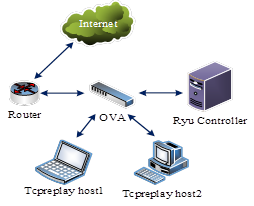Application-Based Online Traffic Classification with Deep Learning Models on SDN Networks
DOI:
https://doi.org/10.46604/aiti.2020.4286Keywords:
software defined network, network traffic classification, deep learning, tensorflowAbstract
The traffic classification based on the network applications is one important issue for network management. In this paper, we propose an application-based online and offline traffic classification, based on deep learning mechanisms, over software-defined network (SDN) testbed. The designed deep learning model, resigned in the SDN controller, consists of multilayer perceptron (MLP), convolutional neural network (CNN), and Stacked Auto-Encoder (SAE), in the SDN testbed. We employ an open network traffic dataset with seven most popular applications as the deep learning training and testing datasets. By using the TCPreplay tool, the dataset traffic samples are re-produced and analyzed in our SDN testbed to emulate the online traffic service. The performance analyses, in terms of accuracy, precision, recall, and F1 indicators, are conducted and compared with three deep learning models.
References
M. N. A. Sheikh, “SDN-Based approach to evaluate the best controller: internal controller NOX and external controllers POX, ONOS, RYU,” Global Journal of Computer Science and Technology, vol. 19, no. 1-E, February 2019.
H. C. Chu, Y. X. Liao, L. H. Chang, and Y. H. Lee, “Traffic light cycle configuration of single intersection based on modified Q-Learning”, Applied Sciences, vol. 9, no. 21, article 4558, October 2019.
S. Rezaei and X. Liu, “Deep learning for encrypted traffic classification: an overview,” IEEE Communications Magazine, vol. 57, no. 5, pp. 76-81, May 2019.
M. Abadi, P. Barham, J. Chen, Z. Chen, A. Davis, J. Dean, et al, “Tensorflow: A system for large-scale machine learning,” 12th USENIX Conference on Operating Systems Design and Implementation, August. 2016, pp. 265-283.
“Keras,” https://keras.io/, June 2019.
“Open Networking Foundation,” https://www.opennetworking.org/, June 2019.
“Ryu SDN Framework Community,” https://ryu-sdn.org/, June 2019.
“Tcpreplay,” https://tcpreplay.appneta.com/.
G. Draper-Gil, A. H. Lashkari, M. Mamun, and A. A. Ghorbani, “Characterization of encrypted and VPN traffic using time-related features,” Proc. 2nd International Conference on Information Systems Security and Privacy, February 2016, pp. 407-414.
J. Xie, F. R. Yu, T. Huang, R. Xie, J. Liu, C. Wang, and Y. Liu, “A survey of machine learning techniques applied to software defined networking (SDN): Research issues and challenges,” IEEE Communications Surveys & Tutorials, vol. 21, no. 1, pp. 393-430, 2019.
P. Amaral, J. Dinis, P. Pinto, L. Bernardo, J. Tavares, and H. S. Mamede, “Machine learning in software defined networks: Data collection and traffic classification,” IEEE 24th International Conference on Network Protocols, IEEE Press, November 2016, pp. 1-5.
P. Wang, S. C. Lin, and M. Luo, “A framework for QoS-aware traffic classification using semi-supervised machine learning in SDNs,” Proc. IEEE International Conference on Services Computing, IEEE Press, June 2016, pp. 760-765.
R. Thupae, B. Isong, N. Gasela, and A. M. Abu-Mahfouz, “Machine learning techniques for traffic identification and classification in SDWSN: a survey,” 44th Annual Conference of the IEEE Industrial Electronics Society in Iecon, IEEE Press, October 2018, pp. 4645-4650.
H. K. Lim, J. B. Kim, J. S. Heo, K. Kim, Y. G. Hong, and Y. H. Han, “Packet-based network traffic classification using deep learning,” International Conference on Artificial Intelligence in Information and Communication, IEEE Press, February 2019, pp. 046-051.
P. Wang, F. Ye, X. Chen, and Y. Qian, “Datanet: deep learning based encrypted network traffic classification in SDN home gateway,” vol. 6, article 18174852, pp. 55380-55391, September 2018.
R. Hajlaoui, H. Guyennet, and T. Moulahi, “A survey on heuristic-based routing methods in vehicular ad-hoc network: Technical challenges and future trends,” IEEE Sensors Journal, vol. 16, no. 17, pp. 6782-6792, September 2016.
A. Azzouni, R. Boutaba, and G. Pujolle, “NeuRoute: predictive dynamic routing for software-defined networks,” 13th International Conference on Network and Service Management, IEEE Press, January 2017, pp. 1-6.
J. Carner, A. Mestres, E. Alarcn, and A. Cabellos, “Machine learning based network modeling: an artificial neural network model vs a theoretical inspired model,” Ninth International Conference on Ubiquitous and Future Networks, IEEE Press, July 2017, pp. 522-524.
T. H. Lee, L. H. Chang, and W. C. Cheng, “Design and implementation of SDN-based 6LBR with QoS mechanism over heterogeneous WSN and internet,” KSII Transactions on Internet & Information Systems, vol. 11, No. 2, pp. 1070-1088, February 2017.
N. Sultana, N. Chilamkurti, W. Peng, and R. Alhadad, “Survey on SDN based network intrusion detection system using machine learning approaches,” Peer-to-Peer Networking and Applications, vol. 12, no. 2, pp. 493-501, January 2018.
C. Song, Y. Park, K. Golani, Y. Kim, K. Bhatt, and K. Goswami, “Machine-learning based threat-aware system in software defined networks,” 26th International Conference on Computer Communication and Networks, IEEE Press, July 2017, pp. 1-9.
T. Hurley, J. E. Perdomo, and A. Perez-Pons, “HMM-based intrusion detection system for software defined networking,” 15th IEEE International Conference on Machine Learning and Applications, IEEE Press, December 2016, pp. 617-621.
“OpenWrt,” https://openwrt.org/, June 2019.
“scikit-learn,” https://scikit-learn.org/stable/index.html, June 2019.
M. L. Zhang and Z. H. Zhou, “A review on multi-label learning algorithms,” IEEE Transactions on Knowledge and Data Engineering, vol. 26, no. 8, pp. 1819-1837, August 2014.

Published
How to Cite
Issue
Section
License
Submission of a manuscript implies: that the work described has not been published before that it is not under consideration for publication elsewhere; that if and when the manuscript is accepted for publication. Authors can retain copyright in their articles with no restrictions. is accepted for publication. Authors can retain copyright of their article with no restrictions.
Since Jan. 01, 2019, AITI will publish new articles with Creative Commons Attribution Non-Commercial License, under The Creative Commons Attribution Non-Commercial 4.0 International (CC BY-NC 4.0) License.
The Creative Commons Attribution Non-Commercial (CC-BY-NC) License permits use, distribution and reproduction in any medium, provided the original work is properly cited and is not used for commercial purposes.







